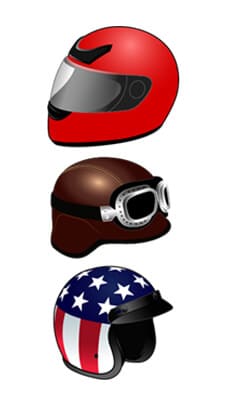
Most riders know the risks involved with motorcycles in this rapidly growing state, yet they continue to ride because of the passion they have for their bikes. As the population density of Texas has grown, particularly in metropolitan areas such as Dallas and Fort Worth, so have the number of motorcycle injuries. According to the Insurance Institute for Highway Safety (IIHS) in 2017 367,865 motorcycles were registered in the state of Texas. Each year that passes the number of riders that have either been killed or have sustained serious bodily injuries have inched further up. According to the Texas Department of Transportation in 2017, in Texas 501 motorcycle riders suffered fatalities as a result of collisions. Fifty-two percent of those riders were not wearing helmets. But what happens when a biker gets hurt in an accident on the road? What are the basics an injury victim should be know when seeking a motorcycle accident lawyer in Dallas? Read this article to find out!
Issues that an accident victim should think about:
Many factors can determine the strength of a motorcycle claim. Here are some issues that should be taken into consideration by a claimant:
- What is offending driver’s financial scenario? Does he/she have deep pockets?
- Was the offending driver insured? If so what are his/her policy limits?
- Was the collision the result of a hit and run? If so, was a police report filed?
- Does the claimant have uninsured/underinsured coverage on the motorcycle or possibly
- another vehicle the claimant owns?
- How will the insurance company or a jury perceive the claimant? What is the demeanor,
- education, family, and employment history of the claimant like?
- What is the claimant’s motorcycling history? Prior accidents? Proper operator’s license?
- Was the claimant wearing a helmet?
- Was there any alcohol or substance abuse at play?
What is the Texas Transportation Code’s Definition of a Motorcycle?
- Motorcycle

Texas Transportation Code (“TRC”) section 541.201(9) defines a “motorcycle” as a motor vehicle, other than a tractor, that is equipped with a rider’s saddle and designed to have when propelled not more than three wheels on the ground.” To legally operate a motorcycle, residents must obtain a class M license which permits riders to ride any motorcycle with an attached motor, or a motorized scooter. Individuals must go through the licensing process by completing an application, providing proof of identity, taking a motorcycle safety course, passing a written test, taking and passing motorcycle drive test, and paying a $35 fee.
- Mopeds
TRC section 541.201(8) defines a “moped” as a “motor-driven cycle that cannot attain a speed in one mile of more than 30 miles per hour and the engine of which: (A) cannot produce more than two-brake horsepower; and (b) if an internal combustion engine, has a piston displacement of 50 cubic centimeters or less and connects to a power drive system that does not require the operator to shift gears.” Motorized bicycles have become relatively common in Texas but have caused serious injuries due to their high speed.

I Failed to Wear a Helmet. Can it Impact My Case?

In Texas, pursuant to TRC section 551.001, motorcycle riders or passengers under the age of 21 must wear a helmet. Those who are 21 and over must wear a helmet per the same law unless: (1) they have completed an approved motorcycle driving training and safety course, or (2) they are covered by a health insurance policy that provides medical benefits for injuries sustained as a result of a motorcycle accident. Motorcycle riders who get into accidents and fail to wear helmets will not have their claims completely barred. But Texas does use a modified comparative fault system which reduces a driver’s damages proportionally by the driver’s own contributory fault in causing the injury (by for example failing to wear a helmet). This means that if you fail to wear a helmet, it could significantly impact your case if it is determined that it contributed to your injuries.
Who is Responsible for My Injuries?
- Individuals:
- Drivers on Texas streets must exercise “ordinary care” which means they must act as reasonably a prudent person would act in similar situations when operating motor vehicles on Texas streets. They are expected to be observant, and maintain a reasonable lookout for foreseeable events and conditions. Drivers who act negligently are personally liable to individuals they injure and must compensate them accordingly for whatever injuries they sustain and damages they suffer.
- Employer:
- Employers of a negligent driver that caused an accident while on the job can be responsible under the theory of respondeat superior or vicarious liability. This means that an injured motorcyclist (in addition to the actual individual that caused the accident) can bring a lawsuit against a company if the employee that caused the accident was acting within the scope of employment. Bringing a claim against a large company with deep pockets is often ideal, and large companies often have insurance policies with greater limits than individuals.
- Manufacturer:
- Manufacturers of defective products can be responsible under a theory called “strict products liability” for injury to persons or property caused by those defective products. This theory allows a plaintiff to cast a much wider net and name as a defendant any person or company that participated in the manufacturing or marketing of a defective product or in placing it in the “stream of commerce.” Often the “stream of commerce” means the manufacturer, distributor, retailers, etc.
What Should I Do After I get into an Accident?
- Escape danger from the accident scene:
- Freeways and roadways can be extremely dangerous places, especially right after an accident takes place. Immediately after an accident takes place a driver should move to the shoulder to ensure they do not collide with other motor vehicles that may be closely following.
- Call the police:
- Although often times the actual police report may be inadmissible in court, it is beneficial to have police investigating the accident scene. They generally will appear at the scene and take pictures, take measurements, interview witnesses, and come to a conclusion on what exactly happened and who was at fault. Their findings are typically memorialized in a police report that can be obtained either from the local police or the Texas Highway Patrol.
- See a healthcare provider:
- This is an important one, injured victims should obtain medical care as soon as possible. Too many times plaintiffs wait long periods of time to see a doctor and insurance companies try to use this as a Defense, to state that either there was an intervening cause during the period time (i.e. the person was injured in another accident), or to claim that the plaintiff failed to mitigate his/her damages. Get proper medical care as soon as possible to avoid this.
- Obtain legal representation:
- Don’t just get on the phone and provide a recorded statement to the defendant’s insurance adjuster. Anything you do or say can be used against you. Claimants often screw this up and state all kinds of admissions, omissions, or inaccuracies. Get an attorney that will do the talking for you so that you can be ensured that you are not hurting your case.